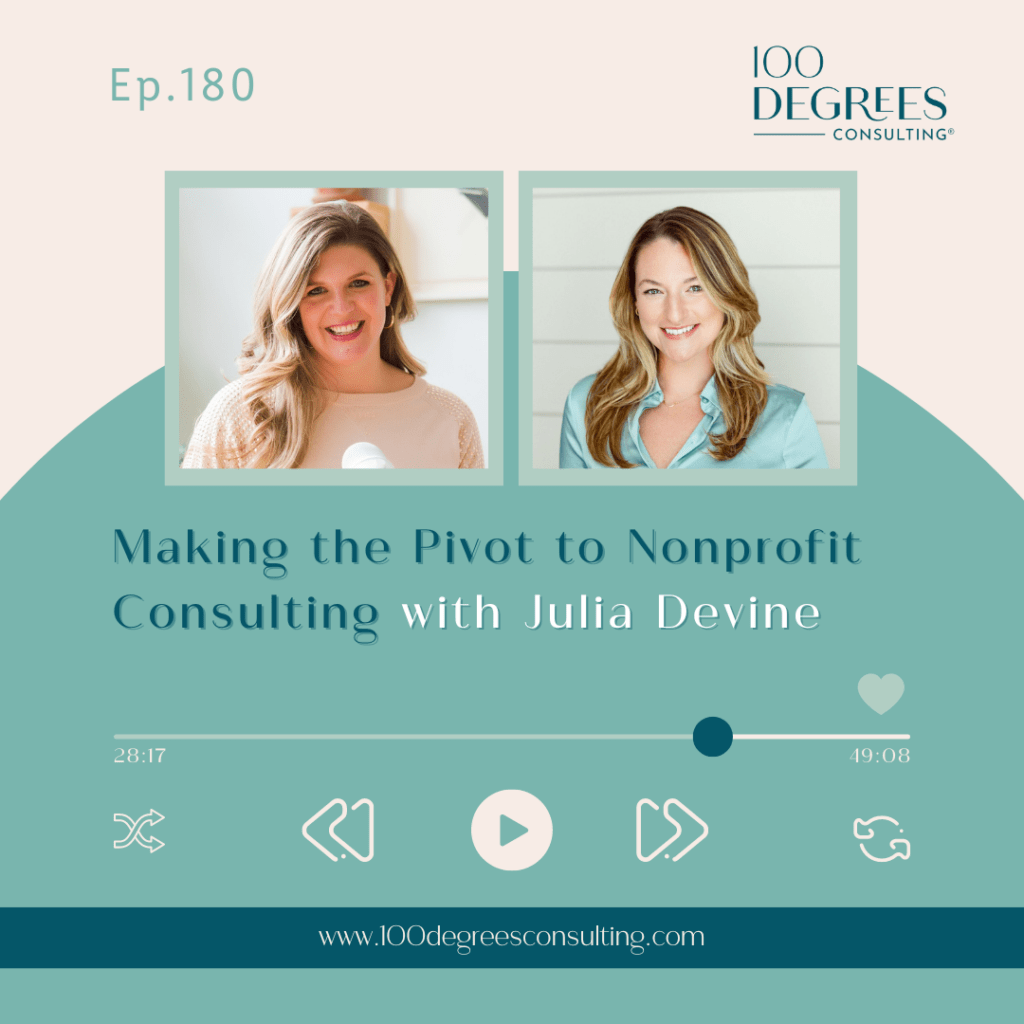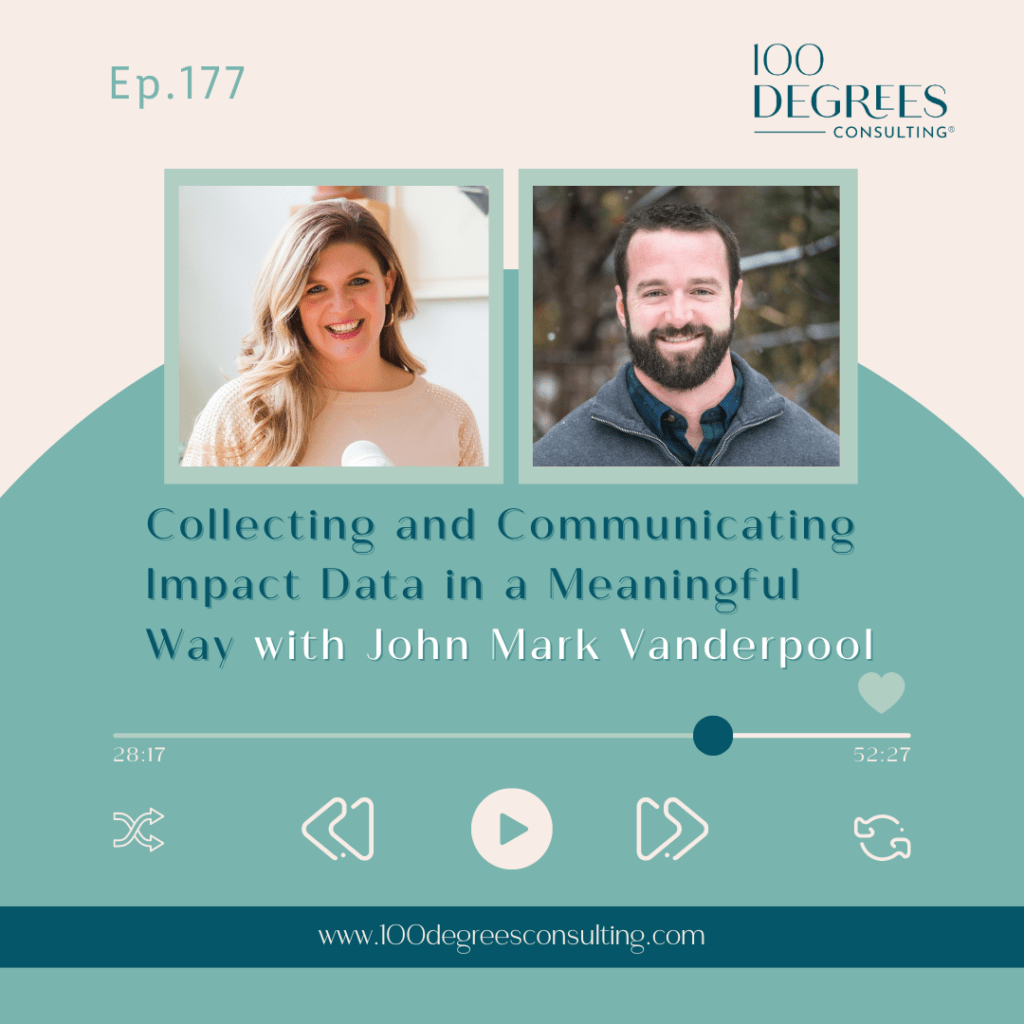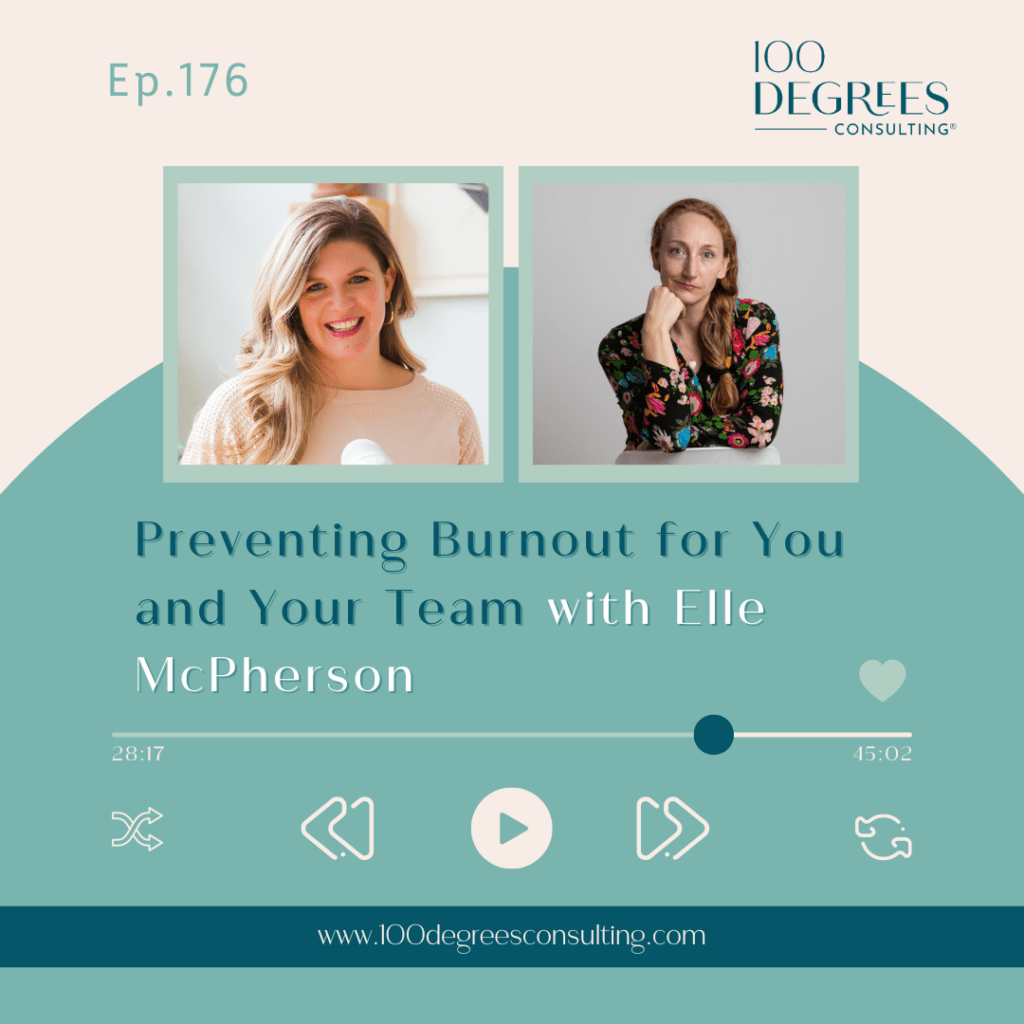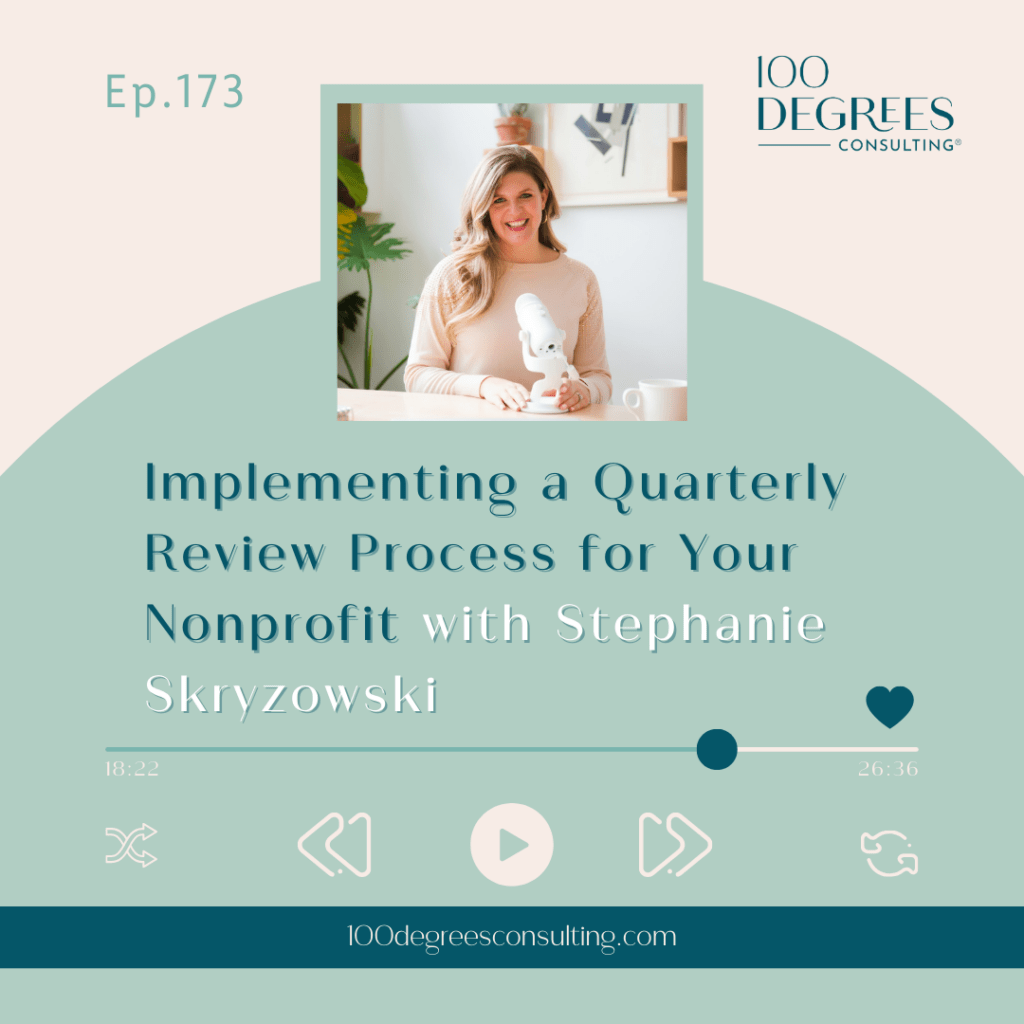Transcript Episode 147 – Using Your Budget to Support TeamFundraising Strategies for Small Nonprofits with Cindy Wagman on The Prosperous Nonprofit
Stephanie Skryzowski: [00:00:00] Welcome to the Prosperous Nonprofit, the podcast for leaders who are building financially sustainable and impactful nonprofits and changing the world. I’m Stephanie Skrzewski, a chief financial officer and founder and CEO of 100 Degrees Consulting. My personal mission is to empower leaders to better understand their numbers, to grow their impact and their income.
On this show, we talk to people who are leading the nonprofit sector in new. Innovative, disruptive, and entrepreneurial ways creating organizations that fuel their lives, their hearts, and their communities. Let’s dive in.
Hello. Hello. Welcome back to the Prosperous Nonprofit. I’m excited to be here with you today with Cindy Wagman. So, Cindy and I met, I think, back in maybe 2015, [00:01:00] 2016. We had both just started our businesses and somehow stumbled into each other online. And we met via Zoom and we were just at the very early stages of our journeys.
And it’s so cool to think about that little Zoom meeting and then where we are today eight years later. So if you don’t know Cindy Wagman, um, first of all, you’re going to get to know her today, but let me tell you a little bit about her. So Cindy is challenging the status quo when it comes to nonprofit consulting.
As a nonprofit pro turned in demand coach, consultant, and speaker, Cindy empowers nonprofit serving consultants to shake off the shoulds, drop the nonprofit scarcity hangover, and find abundance in entrepreneurship. Uh, she is the co host of the Confessions with Jess and Cindy podcast. She’s the author of the bestselling book, Raise It, the Reluctant Fundraiser’s Guide to Raising Money Without Selling Your Soul.
And she’s the founder of the Fractional Fundraising Movement. And so [00:02:00] basically Cindy has spent 20 years fundraising for nonprofit organizations, both as, you know, in the capacity of an in house fundraiser, as well as this fractional fundraiser model. Now, listen, if you’ve not heard. What a fractional fundraiser is.
If you’ve never heard that term before, Cindy breaks it down for us so nicely. I asked her to explain it to me, like I’m five Allah, Michael Scott. And she did, she did a great job of explaining exactly what a fractional fundraiser is and who this model is really good for both on the nonprofit side, as well as the fundraiser side of things.
And so, you know, on this podcast, we’re talking about how organizations and leaders are working in new. Innovative, disruptive, creative, entrepreneurial ways within the nonprofit sector. And I think this model of fractional fundraising is absolutely it. So I’m really excited to have you all listen to our conversation [00:03:00] because whether you are leading a nonprofit organization and you are in desperate need of some really smart, really strategic, high level fundraising support, and maybe you have a limited budget.
Or you are a nonprofit fundraiser who’s working in an organization, but really looking for more freedom with your time and really wanting to continue serving organizations that you’re passionate about, Cindy and her expertise in this episode are going to be a great resource for you. for you. So without further ado, let’s go talk to Cindy.
Hey everybody, welcome back to the Prosperous Nonprofit. I’m really excited to have with me today, Cindy Wagman, Cindy, welcome. Thank you so much for having me. I’m super excited to chat and this is great timing because I was just on your podcast. And I think that episode [00:04:00] just launched a few weeks ago. And so it’s fun to be able to kind of talk on this side of things today.
But I would love if you could tell our listeners a little bit about who you are and what you do.
Cindy Wagman: Absolutely. So I am Cindy. I have been. I always like to say like working in the nonprofit sector is kind of like in my blood. Uh, it’s the only thing I’ve ever known. I started volunteering in high school. It was such an important part of my university experience.
And as soon as I graduated, I became a fundraiser, actually wrote a thesis in my undergrad on feminist fundraising. So this has been, I’m one of those few people who was like, okay, that’s my career choice. I’m going to do that. So I was fundraising. I have been fundraising for over 20 years, but over the last couple of years, well, I started my business, um, doing fundraising for small nonprofits in 2015, [00:05:00] uh, I think around that time, I met you somewhere, maybe a little bit after that, and then.
Over the last few years, it’s shifted, and so instead of me working directly with charities and building my team, I actually now help, uh, experienced fundraisers become fractional fundraisers so that they can work with more charities, and I help non profit serving consultants build their business.
Stephanie Skryzowski: That’s amazing.
That’s so cool. Zen, I think you’re right that you are one of the only people I’ve spoken with. That’s like, Oh yeah, I, I started my career in fundraising. Like that’s what I wanted to do. It’s like pretty much every nonprofit person I know falls into their job for one in one way or another. That’s incredible.
So you’ve seen a lot of things in the nonprofit sector over the last 20 years in fundraising trends. Like, what are [00:06:00] some of the big things that kind of pop out to you as you’ve sort of ridden this wave over the last 20 years?
Cindy Wagman: Yeah, honestly, the trends, the trend might be that there are no trends, in the sense that the best fundraising really It’s about relationships and it’s about finding the people who want to change the world in the way that your nonprofit is changing the world.
And that is true and has always been true. And yes, technology has changed. Oh my goodness. Like we used, I mean, we didn’t have email newsletters when I started fundraising, right? Um, so, or APLs, like none of that social media, I don’t think maybe barely. No, it didn’t exist for the masses. So I remember when, when Twitter started and the board, my board was like, we need to be on Twitter and I kept asking, well, why, like [00:07:00] maybe, but maybe not just because it’s a trend doesn’t mean it aligns with our work.
And at that time I was in a small organization and all of our donors were like over 65, I was like, they’re not on Twitter. We don’t need to be on Twitter. So, yeah, the fact is. At the end of the day, I always like to say the best answer in fundraising is it depends because the right thing for your organization is not going to be what’s trendy or anything like that.
It’s going to be what’s mission aligned, what’s aligned with your communities and supporters, and that builds meaningful long term relationships.
Stephanie Skryzowski: Hmm, that’s so good. And I would imagine that like, if building meaningful relationships is kind of the center and that almost is the answer, maybe the medium for that looks different depending upon your people, your communities, the people that you serve and your donors and things.
But the centerpiece is the relationships. Exactly. [00:08:00]
Cindy Wagman: Exactly. Yeah. Yeah. Like some, back in the day, you know, it was phone calls. Now maybe DMs or text messages, but at the end of the day, yes, the tactics will change and vary, but the principles are the same. Mm
Stephanie Skryzowski: hmm. Oh, I love that. That’s so good. And it’s just encouragement for any listeners that if you work in an organization and you’re feeling pressure to like get on TikTok and like do silly dances or whatever it might be like, you probably don’t have to do that.
Like that might not be where your people are. I love that. I have not, I’m, I’m not a TikTok adopter. I think I downloaded the app for a couple of weeks, I don’t know, a year or two ago and it’s, I don’t, it’s gone. I don’t, I don’t pay attention to TikTok.
Cindy Wagman: Very fascinating. I mean, I have to say, I actually like, I consume a lot of content on TikTok and I posted one video.
No, I’ve posted a number of videos. There was a time where I was experimenting because I also personally like to experiment with [00:09:00] things and I was experimenting and creating videos around fundraising content. And it’s really funny because the one thing that’s true of TikTok and I would say LinkedIn that I don’t see as much on.
Other platforms is that they’ll keep pushing your content long after it’s like you create it. So I still get follows from a post. I think I made this, I want to say two summers ago, maybe, but I have this post that’s like, I don’t know, had over 20 or 30, 000 views, which is bonkers. And if you compare that to other mediums, um, but.
It’s still, I’m not actively creating on TikTok right now because even with that, it’s still not a good use of my time. Mm hmm. And my focus has changed, yeah.
Stephanie Skryzowski: Yeah, and I think it’s important to like, recognize that and be okay with moving on. I [00:10:00] had a long time where I was like, okay, well, we have to be posting on Facebook, like X number of times a week.
And I’m like, wait a second. Nobody is seeing this. Like, this is not a good use of our time. And so we don’t post anything on there anymore. And it’s, you know, it’s a sad, sad, lonely little business page, but, but it’s exactly, it’s not doing anything. So it’s like, it’s okay to let go if something is not
Cindy Wagman: working.
Exactly. I’ve let go of a lot of. Things this past year, um, as I’ve shifted in my business and, um, it’s really scary, especially when you work to build something, right? There’s that sunken cost fallacy where it’s like, well, I’ve already invested in this. Um, I’m losing out if I let go of it, but honestly, it’s the best thing that you can do is really double down on the things that are working and let go of other things.
That aren’t working anymore.
Stephanie Skryzowski: Such good advice. [00:11:00] I definitely want to get more into what the transition of your business has looked like, but you mentioned LinkedIn. I think you said LinkedIn and Tik TOK, like sort of push your content. Do you find that’s the case on LinkedIn? I find
Cindy Wagman: some content on LinkedIn does have a longer life than just like.
The day you post so definitely still sometimes I find people will comment like a week after or two weeks after and I don’t think that happens on other platforms in the same way so I, but it has to have good engagement for linkedin to keep pushing it.
Stephanie Skryzowski: That’s cool. I’ve noticed that too and haven’t really thought much about it, but I’m like, you know, I look at my notifications and somebody comments on a post that I posted like a week ago.
I’m like, Oh, I forgot. Like I forgot about that already, but that’s interesting that it’s yeah, that there’s another comment on it. So. Kind of cool. It’s still out there. Yes. So I just asked sort of like fundraising trends over time. What have you seen in terms of fundraising [00:12:00] teams? Like what does the development team looked like when, you know, 20 years ago or 15 years ago when you started getting into this space versus what do fundraising and development teams look like now?
Or what, what trends have you seen? What does the evolution looks like?
Cindy Wagman: Yeah. Okay. There’s so much. I, I would say previously, like when I started, things were still like most people were not professional fundraisers of the profession of fundraising wasn’t as established as it is now. So, for example, I think there was a fundraising college.
Diploma or degree that you could get, but very few, like it wasn’t the thing. Whereas now, where I am, and, and there’s master’s programs in philanthropy and fundraising and all this kind of stuff. So it wasn’t the institutionalized quote unquote professionalism that, that we see today. And I would say. At that time, there were lots of [00:13:00] jobs like there was lots of opportunity and there were lots of people looking for work so you could sort of fall into fundraising if you wanted to, or if it felt like an interesting opportunity and, you know, people were building teams.
Now it’s a different market. I think our sector is really burnt out and there aren’t as many fundraisers for the jobs that are open. So I see a lot of organizations struggle filling positions or if they have like a parental leave or. Someone does leave they just redistribute that work to the existing people, which is not fair, but it’s kind of especially these days with fear about the economy and all of that.
I think organizations are trying to really squeeze as much. out of their people as possible, [00:14:00] um, which I don’t agree with. And I think it’s going to be very detrimental. Um, so it’s a hard, it’s hard for organizations right now to invest well in their fundraising growth from a staffing perspective. Like I’ve seen organizations post and repost and repost the same job that they can’t fill.
I had an organization say they had a posting open for a year. And for small organizations, which are the ones that I particularly love, it’s hard to find someone who has experience at your budget, right? So very, and I, I liken this to my early experience as a fundraiser in a very small organization where I think at the time I was making around 4, 000.
45, 000 a year. And at that price, like really, you can only get someone who’s right out of school who doesn’t have that much experience. [00:15:00] But the amount of time I spent doing things that were not really productive or helpful for our fundraising, like I was learning on the job and we all like learning on the job is not a bad thing.
We all want to be consistently learning, but I did a lot of. Stupid things. I did a lot of things where my board would have ideas. Um, and I would just like say, okay, like they’re like, we need to write a letter to Oprah. And I was like, well, who am I to push back on the board? So I wrote a letter to Oprah, or I just came back from speaking at the nonprofit storytelling conference.
And it was really interesting. You know, consistently we’ve known for years in direct appeal, like mailed, uh, appeals, letters that perform the best are longer. So like four pages, right. And we’ve known this for a long time. There’s lots of evidence for that, but I’d go and I’d write a four page letter in my organization and the [00:16:00] fundraise, the chair of the fundraising committee would come with her red pen and cross out 80 percent of it.
Cross out all the stories, which we also know work well and just be like, no, it has to be a page and a half really like statistics based and you know, like the business case. And I was like, you are wrong. And I’m too inexperienced to push back on this. And so I’ve seen for small organizations consistently.
And this was true then. And it’s true now that There’s a lot of stuff that they’re doing that they shouldn’t be doing. And part of that is because they just don’t have the experienced staff.
Stephanie Skryzowski: Yeah. Well, when the mass doesn’t work, like getting someone with the experience at the budget that they have available, like it’s not like if the math is, it’s just not going to work.
And so. That’s one great example of sort of like the trickle down effect of this organization, not having the budget to hire a more experienced person, [00:17:00] but what else, I mean, I can’t imagine having a fundraising role and I would imagine like a, uh, primary fundraising role empty for a year. Like what is the effect of that on the organization?
Like,
Cindy Wagman: So I always say the best fundraising, you heard me say at the beginning, you know, it’s based on relationships, but also it’s based on being consistent, actually doing the work regularly. There’s no magic. It is about showing up and asking stewarding those relationships, you know, Building up over time.
And when you stop, my friend, Mike calls it the fundraising flywheel. And I don’t, I didn’t know what a flywheel was when he told me this, but now I do. Cause he explained it, but it’s once you get it started, it operates a [00:18:00] little bit on inertia. So it’s a heavy push at the beginning and then it’s a lot lighter of a load.
And so. That is true of fundraising, but when you stop for a year or when you don’t do the, when you don’t have the consistency, or usually what happens when people don’t, when they have that empty position, they might do one or two things like they might Still do their year end ask, but they’re not doing all the stewardship and relationship building that makes that year end ask successful.
And so the flywheel stops and then it takes double the investment, double the effort to get it started again and. The opportunity costs are lost, like actual lost money coming into your organization. So it’s, um, it’s like the opposite of compounded growth, right? Like when we do things consistently, it grows over time and you start to see things, you know, [00:19:00] grow exponentially.
Whereas when you stop, it plummets quite quickly. Oh,
Stephanie Skryzowski: that flywheel like image and, or like. Metaphor. Whatever it’s called. It’s so powerful. And like I have created a flywheel for my company and figured out like what’s at the top of the flywheel and what’s like, it gets it like, how can I continue to put more energy into the top of that flywheel so that it can just like keep going on its own.
And I think that the idea is so powerful and you’re right. If you like stop feeding that flywheel, it’s going to, it’s going to creak to a halt.
Cindy Wagman: And then you need to push. So much harder, which means like more investment. I mean, even if you look at the cost of onboarding new staff and training them and and all of that is is significantly more effort.
Stephanie Skryzowski: Yeah, yeah, absolutely. And I would imagine that this is somewhere that your model of this [00:20:00] fractional fundraising Can kind of come in and fill this gap and this need. And so talk to us about fractional fundraising. What did this mean? What does this mean? Like, explain it like I’m five, because, uh, like I said, I was just talking to somebody yesterday that she’s like, I just heard like, she’s, I think she’s a marketing person for nonprofits.
She’s like, I just learned about the term fractional and like my mind is blown and we are fractional CFOs. And I often, when I say that people are like, wait, what, what does that mean? So tell us what fractional fundraising
Cindy Wagman: is. Yeah. So this model was born out of the experience I just talked about, you know, being in those positions.
And when I started consulting, I was working with small organizations and, you know, I’d get, I’d do some coaching or I’d give them a fundraising plan. And nothing would happen. And I got really frustrated because as I said, the magic is in the [00:21:00] doing consistently. And so I was like, well, no, what organizations really need is just hands on implementation and the strategy, the strategy or strategic insight.
To know where to put focus that that implementation and so that’s sort of where we started doing fractional fundraising first in house. And now I train other people, but the idea. So I’m trying to think it’s like 5 year olds understand fractions yet, but I don’t think they do. So. Fraction, fraction is a term that describes a part of a whole, right?
So if we think of a whole, you can divide it into four, and each part is a quarter, or a fourth, which is a fraction. One over four is literally how we, uh, show fractions. And so when you hire a fractional executive, so that could be a fractional fundraiser, a fractional [00:22:00] CFO, a fractional CMO, um, and there’s fractional HR, like there’s tons of ways that these, these People can help you, but you are getting a part of their time for a part of the overall value they bring to any organization, so you would pay them for And I usually recommend, uh, working on long term retainers with fractional executives, because that’s, again, it’s that long term consistent work that it’s really pays off.
And so you’re working long term it’s very predictable and steady. You’re not paying for hours. You, you know, exactly what the work and deliverables are. And the fractional executive gets the work done. They bring the strategy and then they get it done. So for fundraising, that means you’re going to have someone probably with 10, 15 [00:23:00] years or more experience fundraising, who’s a generalist so that they can, um.
Understand and make decisions about what fundraising to what fundraising tactics to employ, because a lot of organizations are just doing the wrong things, and they’re going to bring that strategy, create a fundraising plan for you and then implement the plan. So. It really is like, I call it from strategy to stuffing envelopes, and literally someone of our fractional fundraisers just posted on LinkedIn a photo of the envelopes she was stuffing.
Um, but that’s what it takes to be successful. And it doesn’t, once you’re experienced, it doesn’t take the same amount of time. As it would for someone just starting out, so it allows small organizations to stretch their budget and access much higher experience without compromising on [00:24:00] some of those day to day activities.
That is where the magic is. Oh my gosh. Was that understandable for a five year old?
Stephanie Skryzowski: I think so. I’ll have to have my seven, seven year old listen to this and see what she thinks. No, totally. Um, well, I think that is so powerful. And I think even putting some numbers to that, like if a budget, if an organization is like, okay, we have 50, 000 available for the salary.
Great. Well, you have two choices. You can hire someone who has the experience level that Goes alongside a 50, 000 salary, or you can hire an executive. And I love how you use that term multiple times. You can hire an executive for a fraction of their time. And frankly, their experience has probably helped them become like much more efficient.
So they can be like highly productive, highly effective in less time. And. Like you’re getting such a higher level of expertise. And I mean, that’s huge to be able to get that strategy along with just the [00:25:00] day to day work. So for your friend, I was looking, um, when you were talking, I was looking on LinkedIn.
Cause I definitely saw that post from somebody who had like had a picture of the envelopes. I was like, that’s, that’s really interesting that it’s not just. strategy. It’s not just like these high level relationships. It’s like, Oh, we’re getting our end of year appeal out the door and here’s how we’re, we’re signing, you know, a thousand letters.
Hey there, amazing listeners. I hope you’re enjoying another fantastic episode of the prosperous nonprofit. Before we dive back in, I have a quick favor to ask. That’s right. If you are getting value, knowledge, encouragement, or even just good vibes from our show, please share The Prosperous Nonprofit with a friend or colleague who you think would love it as much as you do.
It’s like passing along a good book or recommending your favorite local coffee spot. Please take a quick second to hit that share button, send a link, or even give a shout out on social media. Your support means the [00:26:00] world to me. Thank you for being awesome. Thank you for being here. And now back to the show.
That’s really interesting that it really can be that whole spectrum of work from the strategy down to the stuffing envelopes and everything in between. Do most fractional fundraisers or any fractional fundraisers have a team where the most senior person’s doing the strategy and then they employ a team in their business that’s doing different levels of work?
Or is it typically just like one person?
Cindy Wagman: Yeah, so that’s how I started. I had a team and we were exactly like that. So it does exist. But what I’ve found is that for a lot of, so we talked about the benefits for the organization, but for a lot of experienced fundraisers, there’s also really great benefits.
And those I think are most realized when you’re doing this on your own, unless you really want to build a business, [00:27:00] right? So the benefit for fundraisers. Who have been working in the sector for a long time, probably they’re earning potential means that they’re not working for those small grassroots organizations.
They’re probably now working with mid to large size organizations, which may or may not be where their heart is and they’re working for someone else, right? Like you’re constantly at someone else’s back and call. And you just don’t have as much control over the work that you’re doing and all of that, plus there’s a bit of a glass ceiling, right?
A lot of those fundraisers can become fractional fundraisers on their own, make, some of them are doubling their income, and they have the flexibility and, um, Ability to just do the things like [00:28:00] work with their ideal clients. I mean, I talked to so many of them in our network who have young kids. And so they’re picking up kids from school every day at three or when the kids sick, I mean, my kids homesick today, no biggie.
Right. Or yeah, there’s just the flexibility and control and ability to. Work with, uh, with really great organizations is, um, fantastic. And like I said, most people significantly increase their own, um, revenue or income doing this as well.
Stephanie Skryzowski: Yeah, that’s so, I mean, obviously I’m a business owner and doing fractional services, so I’m like, yep, I’m with it and.
Yeah, you’re right. You could work with even if you’ve got four organizations, what those four organizations pay you could stack up to be. I could see how that would easily be double what you’re making in one place and not double your work by any [00:29:00] means. Yeah. So this fractional model of fundraising, you talked a little bit about who it’s right for in terms of becoming a fractional fundraiser.
What type of organizations is this model right for? Like if we have listeners that are like, okay, I’m running, you know, I’m running a nonprofit organization. Fundraising is a huge challenge for us. We have this gap to fill. Is this right for me? Who do you find the organizations that this really works well for?
Yeah.
Cindy Wagman: So, the way I first envisioned it was for organizations that were either ready to hire their first fundraiser and were struggling to find that person, or they’d had really high turnover with that sole fundraiser. And I’ve seen this a lot or not just high turnover, but like they feel burned by the experience.
So they’ve hired someone maybe the last six to eight months and everyone’s frustrated. It’s not a good experience for any of them. [00:30:00] And then they’re like, okay, well. That didn’t work. We’re going to wait another 12, 18 months before we even think about hiring again. So the way I envisioned it was if you’re ready for that fund, that sole fundraiser, and you have the budget to hire someone, but you’re not happy with the options out there, then fractional fundraising is.
Amazing because you get, like, I look at it as a bridge, right? You know, for, I always recommend starting with one year contracts, but like a lot of our fractional fundraisers work with an organization three, four years. And so over that time, you’re bridging their programs so that eventually they can hire that more experienced in house fundraiser.
I have had fractional fundraisers who work in organizations where they might have. More junior fundraising staff person and so they just want more that high level experience [00:31:00] around the the team. And that’s certainly also works, but they’re not doing a whole lot of management. And so, um, yeah, 1, like, usually in a single fundraising shop or very small, very small team.
Stephanie Skryzowski: Mm hmm. Gotcha. So I would imagine that you just shared, I love that you shared some of the qualities of the organization in terms of their size. I would imagine revenue size is small, although that is subjective. What range do you find to this model works best? I mean, I know it varies, it depends, but is there like a sweet spot?
Cindy Wagman: So I would say. Raising money because revenue overall, like I’m in Canada government, the government funding for some organizations is like 98 percent of their budget and they’re raising like 5, 000 a year on a million dollar budget. Right? So that’s not, um, so I like to think of it in [00:32:00] terms of how much they’re raising.
I would say an organization should be probably raising at least like on the low end, I’d say around 50, 000, um, a year. That is low. I’d say 150 is a little bit more. You’re going to start to see the return increase if you are a little bit further. So like 150 to 350 a year definitely is a good is a good sweet spot.
Even half a million. I think some of our fractional fundraisers work with organizations that are raising even more than that. But, um, Thank you. It really depends on the fundraising tactics and the history there. I would say if you’re raising 5, 000 a year, unless you have a really great funder, who’s like, we want to build your capacity.
You’re not going to see that ROI quickly. Right. So, cause we think of fundraising growth and it’s usually [00:33:00] growth. We think of as percentages, right? So if you are increasing your fundraising by. 10 percent on 5, 000. That’s really different than 10 percent on 150, 000. So you’re just not going to make up and 10 percent is pretty high growth for small organizations.
A lot of our fractional fundraisers are bringing in like 20 percent growth and sometimes even more. So the growth is there, but if your base number is like 5, 000, it’s just going to take you more time. To start to see that that investment payoff. And
Stephanie Skryzowski: is there expectations that should be in place when hiring a fractional fundraiser?
Because I know I have seen organizations hire a fundraiser and whether it’s full time or it’s You know, sort of part time fractional. And they’re expecting by like week two, a hundred thousand dollars [00:34:00] is poured in the door. And I’m like, I’m fairly certain there’s a decent runway until really, until that flywheel, that heavy effort until that flywheel starts moving.
So what have you seen? What is that runway? And what are some like reasonable expectations that organizations need to be mindful of when bringing this type of person on board?
Cindy Wagman: Yeah. So the reason I advocate for 12 month contracts, I mean, yes, it benefits the fundraiser, but mostly it benefits the organization because they need to see this as a long term investment.
And they’re going to get frustrated where like by month six, where the money’s not coming in as much. They’re like, what are we investing in? It takes 12 months. At least for things to start to feel like, Ooh, okay, I can see this coming together. So that doesn’t mean you won’t have early wins and stuff like that, but that is the reality of fundraising.
So it needs time. [00:35:00] The other thing is, depending on the organization, I would never ask an organized, like a fundraiser to raise their salary. So what I mean by that is we’ve worked with organizations where the fractional fundraiser is bringing in a lot of money, but because of the organization’s structure or what have you, or their funding priorities, a lot of that is program money or designated for different things.
And so a fundraiser is not always going to bring in those undesignated operating funds. They can try and a lot of it depends on the organization. So, for example, I do see this rhetoric of like, okay, well, you’re going to raise your salary. Well, we worked with an organization. Their annual budget was about 250, 000.
And in one year, we brought in. [00:36:00] I think about 800, 000 in new funding, which is in, like, that is beyond anyone’s expectations. But I would say 95 percent of that, if not more, was designated. It was program funding. And so the organization has to understand that you have to build fundraising into your core budget to be able to sustain it.
So yes, it takes time, and the other question I get asked a lot about is relationships. And so, like any fundraiser, we are not a walking Rolodex. Oh, right. I know you would be surprised. I do hear this a lot and I’ve seen organizations like specifically say they want to hire someone who can bring relationships and bring the donors.
No fundraiser is going to [00:37:00] do that if they have any ethics. The reality is we work on behalf of organizations. We build relationships on behalf of organizations. And so if. I just, I would never expect that. And similarly, if you’re an organization, you wouldn’t want your fundraiser leaving and bringing those relationships with them to the next organization.
That doesn’t help anyone. So respect the relationships are. Should start with the organization and end with the organization and can be nurtured and developed by a fundraiser, whether that’s in house or fractional. Yeah, those are the big ones in terms of like, expectation setting, uh, give it time, know that, oh, one more, one more good one, because this comes up a lot.
It’s really easy to confuse or like forget that the [00:38:00] fractional executive you have has the expertise. Yeah. Because oftentimes we get in there. We’re doing the day to day work. And so you think of them as like an implementer and I’ve seen organizations and start to delegate more work to them, but your fractional executives.
Are also the experts. And so you actually want them to push back. You want them to tell you where the boundaries are. You want them to tell you when things are not strategically a good idea and you need to listen. So I’ve seen this a lot with organizations where they’ll bring in a fractional fundraiser.
Who will go and create a campaign and then we’ll like tear apart the campaign. This isn’t how we talk about this, or, you know, this isn’t how I, you know, the language we use and. As long as it’s not hurting your mission to use that language or do things the way the fundraiser is doing it. [00:39:00] Trust them because they know what they’re doing.
Stephanie Skryzowski: Yeah. Likely you brought them in to do something different than what you’ve done before. Probably wasn’t working. So like, maybe let’s let them do that. I am so glad you mentioned the Rolodex because first of all, I think it’s hilarious that we’re still actively using the term Rolodex, but like I have heard this.
So many times using exactly that specific language. Yeah. We’re hiring this new development director and we’re really looking for them to bring their Rolodex to this organization. Like I’ve heard that so many times in exactly that way. And I think what you just said about like, wait, you wouldn’t want your fundraiser leaving and then taking all of your donors and the contacts that they made at your organization to the next.
So why would you. On the incoming side, that just doesn’t, it doesn’t make any sense. And I think, you know, it is much more beneficial for the organization. I like how you said, um, they’re building [00:40:00] relationships on behalf of the organization. So then those are relationships with the organization, not just the one person who happens to be sitting in this seat for two years, those relationships will hopefully outlast that person.
And continue on as the next person is sitting in that seat. So I think that’s like a much more sustainable fundraising model anyway. Um, but it’s just crazy how, like, I’m still hearing that language about like hiring a fundraiser to bring their Rolodex. So weird.
Cindy Wagman: Yeah. Understanding the misperceptions about fundraising that exist in our sector is literally a whole other conversation.
I also presented on this at a conference and it’s unbelievable just the myths that are perpetuated. So it’s a very misunderstood function and. The part of the idea of why I like fractional fundraisers is that for smaller organizations, they can start to see what a good, [00:41:00] like what a well run fundraising program looks like on a small budget.
Stephanie Skryzowski: Mm hmm. Yeah, that’s so powerful. And I mean, we see the same thing with financial management and fractional CFOs and our team versus like having nothing. It is, it is huge. So tell me a little bit more about. Your work and what you do now. So you do not do fractional fundraising for nonprofit organizations right now.
You are helping fractional fundraisers grow their business, do their work. Tell, tell us more about what you’re
Cindy Wagman: doing. Yeah. So I help experienced fundraisers become fractional fundraisers. So I have a program called the fractional fundraiser Academy, and it’s a nine month program where I help them set up their business.
Uh, learn how to find clients, do the work effectively. And because I did this and built this in my own business, everything that I teach has been stress tested and tweaked and evolved over [00:42:00] a number of years. So I take all the things that I’ve learned and package it up really nicely to help other people learn it as well and implement it so that they can be their own boss.
Stephanie Skryzowski: Amazing. Amazing. And are you finding that most of the people that are going through your program, are they wanting to build larger businesses or are they more looking for work that lights them up with the combination of more money and more time freedom? Like which direction are they going or is it split?
Cindy Wagman: I would say mostly it’s the latter. Mostly they wanted. There are a couple people who want to build more robust businesses or they sort of evolve into that over time. But at the beginning, most people are looking to take care of themselves and take care of their families, uh, without. You know, compromising on the kind of work that they wanna do.
And uh, yeah, some of them are leaving their full-time jobs. Some of them are already consulting, but not really sure or haven’t found that success [00:43:00] in consulting yet.
Stephanie Skryzowski: Hmm. Is there any conflict of interest between fundraising for multiple organizations at one time? No, I haven’t
Cindy Wagman: come across. So that’s, it’s funny, we have had, I’ve had donors.
Make introductions to organizations where they’re like, Oh, like, I’ll have a connection with a donor through one organization. And they’ll say, you really need to talk to this other organization. I support, they need a you, right? So they’re not, I think for the most part, there’s not actually scarcity around the funds that are available and donors see the value of an organization building up their fundraising program.
And it’s the same thing as if a fundraiser leaves an organization, they have a lot of knowledge that they developed over that time too. So I like to encourage people to [00:44:00] declare and be transparent. So if you are working with two organizations in a really small town, you know, they both should know that you’re working with other clients and I wouldn’t hide who your clients are.
And when you’re engaging with donors, I would, Absolutely be clear that you’re not a full time staff and that you do represent. Uh, organizations and this is the one you’re representing in this conversation. So it has not been a problem and that’s also reflected in contracts and stuff
Stephanie Skryzowski: like that. Sure.
Yeah. I think that transparency is key. And like, if you’re telling people and you’re out in the open about what you’re doing and who you’re working with, then yeah, I, I can see that. Oh my gosh. Well, this has been like such an interesting conversation and I hope that anyone who’s listening, gets an idea of how this model could be applied in their organization.
If you’re working with a nonprofit, working in a nonprofit, or if you [00:45:00] are a fundraiser, how this model might be beneficial to you. And so one of the things that we talk about a lot on this podcast are, you know, how are nonprofits working in new, innovative, disruptive entrepreneurial ways? And I think that’s.
Pretty much what we spent the last 40 minutes talking about, but I would love to ask you one question that I wrap up all of our episodes with. And that question is, what does a prosperous nonprofit look like to you?
Cindy Wagman: Prosperous nonprofit to me is an organization that is looking at Challenging the status quo.
And the assumptions that we’ve been told over and over again. So beliefs like we have no money or donors don’t want to fund overhead. Like just start to challenge a lot of the things, because we actually are sometimes equally, if not more involved in perpetuating those myths [00:46:00] and we have the power to change some of them.
So I would say, look at challenging the status quo and don’t take things for
Stephanie Skryzowski: granted. That’s so good. That’s so good. I think we all know like some of the issues in our sector, but a prosperous nonprofit is the one that’s going to push against that and sort of forge, forge a new way. So, uh, so good, Cindy, thank you so much for being here.
I would love if you could share with our listeners, where can people go to learn more about you, learn more about your work and, you know, especially if they’re interested in becoming a fractional fundraiser, where, where can we find you? Thank you.
Cindy Wagman: Yeah. So from a fractional fundraising perspective, the best place is the good partnership.
com, which will be transitioning to fractional hyphen fundraising. com, but both of those should work. And if you are a consultant who wants to grow your business, you can visit me at cindywagman. com. [00:47:00]
Stephanie Skryzowski: Amazing. Cindy. Thank you. Thanks for being here. I really appreciate it. And I love that you’ve shed a little bit of.
of new light on this model that we’ve been working in, but I think that a lot of people don’t know about. So I really appreciate your time. Thanks for being
Cindy Wagman: here. Thanks for having me.
Stephanie Skryzowski: Before you go, I just want to thank you for being here. To access our show notes and bonus content, visit 100degreespodcast.
com. That’s 100degreespodcast. com. And I’ll see you next time.



















